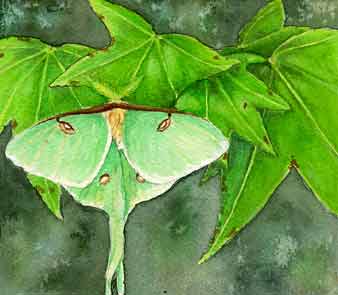|
|
 The Luna Moth The Luna Moth
Story and Illustration by Gary Pendleton
Lunas are ghostly pale green moths. They are remarkable looking creatures with their long, twisting tails and their eye-spots standing out against the cool pale green background of the wings. The eye spots and large size are characteristics that Actias luna shares with other members of the family Saturniidae, the giant silk worm moths.
They have a haunting beauty that can leave a strong impression. I have only seen them on rare occasions. More than 10 years passed between the first time I found one and learned its name and last August, when a healthy specimen appeared in the garden. In the intervening years, I occasionally found fragments of broken luna moth wings, so even though they are scarce, I was reassured that they are not rare and endangered.
The moth that showed up in the garden was hiding out with the beans. I was searching for ripe bean pods when I discovered it, camouflaged in the leaves and vines.
Luna lives are furtive and as brief as the summer, or so it seems. Their life cycle is similar to that of their insect cousins the butterflies: They spend part of their lives in the form of a caterpillar, and another part of their lives, the adult phase, as winged creatures.
The luna caterpillar handles the eating chores for all of the phases of the life cycle. The adult luna moth does not eat; its sole function is to procreate. So to store enough energy to nourish the adult phase, the caterpillars grow to prodigious size.
The luna caterpillar feeds on the leaves of sweetgum, persimmon and black walnut, trees that grow east of the Mississippi, and it is in this region of the country where we see the moth.
My first encounter occurred in the grass of a mowed field in Cape May, New Jersey, in May 1987. I was intrigued by the mysterious creature, beautiful, fragile and as large as the palm of my hand. I was a novice naturalist at the time, so I assumed that the future held at least an occasional encounter.
My familiarity with the natural world grew with experience. Encounters with luna moths were not part of the experience. Years passed before I found one in my beans.
Yet about a month before my second encounter, as I drove through a woods, something pale crossed the road in front of me. It had a weak, bouncy flight; I think it must have been a luna moth.
A little checking on the Internet confirmed that the conservation status of Actias luna is healthy enough. So I guess I’m satisfied, knowing that they are holding their own even in the face of such threats as pesticides and deforestation. I won’t worry if a few years pass until another chance encounter: It’s okay knowing they are there.
Copyright 2001
Bay Weekly
|